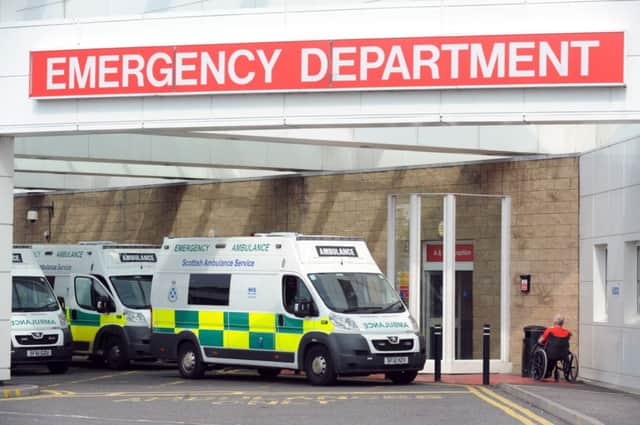Scotland’s A&E waiting time targets missed


The government has bowed to rising political pressure to produce weekly data in line with health boards in England, which revealed 86.1 per cent of patients were seen in January within four hours, against targets of 95 per cent.
The figures also revealed 187 people spent more than 12 hours in A&E.
Advertisement
Hide AdAdvertisement
Hide AdThe worst performing health authority was NHS Greater Glasgow and Clyde (NHSGGC), which saw only 75.9 per cent of patients within the targeted time, with health boards in Lothian, Grampian, Orkney and Lanarkshire among those failing to reach the government-imposed target.
Glasgow’s Western Infirmary was the worst hospital in Scotland with only 57.9 per cent of patients seen within four hours.
NHSGGC chairman Andrew Robertson said: “I am acutely aware of the pressures on staff and the commitment of staff in these challenging times.
“I am also determined to ensure we all work together to find the solutions and to share learning across NHS Scotland to achieve the improvements that will benefit our staff and our patients.”
The struggling health board will receive a £5 million investment to reduce waiting times and special advisers will be sent in to assist at Glasgow’s Western Infirmary, said health secretary Shona Robison.
She admitted more needed to be done but welcomed the fact weekly figures were on par with NHS England and exceeded NHS Wales and NHS Northern Ireland.
Ms Robison said: “I am determined to work with all health boards across the country to improve performance and ensure waits are brought down for patients. Our targets are the most challenging in the UK but it means we need to work even harder to meet them.”
Health boards in Dumfries and Galloway, Shetland, Forth Valley, Highland, Tayside and the Western Isles were among those reaching the targets.
Advertisement
Hide AdAdvertisement
Hide AdBut Labour health spokesperson Jenny Marra said the figures revealed “A&E is in crisis” with waiting times at their worst since 2008, with more than three times as many patients waiting more than 12 hours to be seen.
Patients who have had too much to drink should be taken to recovery centres to reduce the strain on A&E, according to the Scottish Conservatives.
Health spokesman Jackson Carlaw said: ““When so many patients are being sent home from A&E without requiring any significant further treatment, it does suggest that the service is being used far too casually by far too many.
Bed blocking on the rise as Holyrood to invest extra £100m
THE number of patients having to wait longer than the target time to be discharged from hospital has risen slightly again, figures show.
In January this year, 329 patients were delayed more than four weeks after they were ready to be sent home.
This compares with 321 at the October 2014 census and 254 in January last year.
Delayed discharges – also known as bed blocking – happen when patients are ready to leave hospital but their necessary care, support and accommodation arrangements are not yet in place.
The current target states nobody should wait more than four weeks from when they are clinically ready to be discharged. The target is to come down to two weeks in April. The January 2015 census shows a total of 766 delayed discharges, excluding delays of three days or less, compared with 947 in October 2014 and 776 in January last year.
Advertisement
Hide AdAdvertisement
Hide AdThere were 249 patients delayed from four days to two weeks at the January census, compared with 360 in October and 328 in January 2014.
Meanwhile, 517 patients were delayed over two weeks, compared with 587 in October and 448 in January 2014. A total of 224 patients were delayed for more than six weeks at the January census, compared with 215 in October, and 151 in January 2014.
Earlier this year, the Scottish Government announced a further £100 million will be invested in the NHS over the next three years to help cut the numbers of people waiting to be discharged from hospital.
Ministers have said tackling the problem of delayed discharges is a top priority for the administration at Holyrood.
Health secretary Shona Robison said: “Under this government delayed discharge has fallen significantly, with a substantial reduction in the number of patients waiting over three days to be discharged and a fall of two-thirds in the longest waits of over six weeks – from 606 in 2007 to 224 this January.
“However, the statistics from October to December last year show an unacceptably high number of bed days occupied by delayed discharge patients and we are working to reduce this.
“The significant decrease in the number of people waiting to be discharged at the January census is encouraging”
FOLLOW US
SCOTSMAN TABLET AND MOBILE APPS